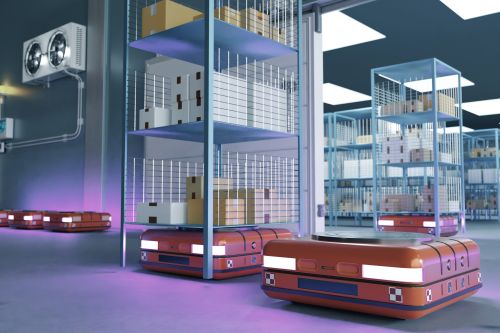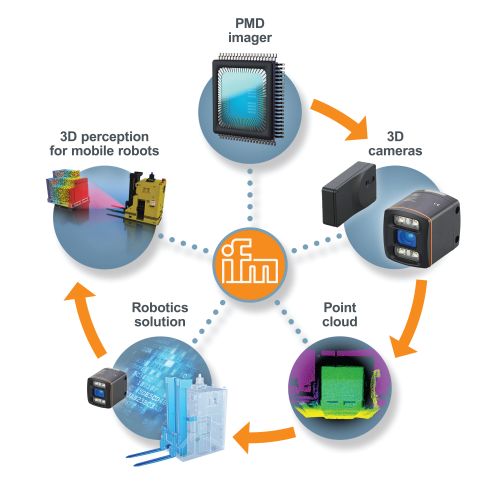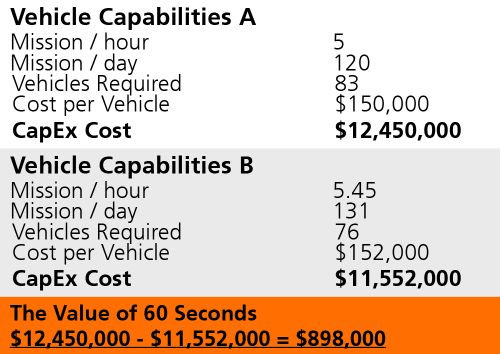
- Autonomous mobile robots
- Business challenges
Business challenges for autonomous mobile robotics companies
What’s holding back your autonomous mobile robot? Can you create a model attractive and cost-effective enough to outshine the competition?
Every AMR company must ask itself those questions. To answer them, you need the right data.
That means understanding why more mid-size and enterprise businesses don't invest in autonomous mobile robotics. It's also knowing where your internal strengths lie – and when you need to look elsewhere for solutions.
We’ve outlined the primary factors behind these challenges. You can click the link in each section to explore the topic further.
To learn how ifm’s mobile robotics solutions can help you, fill out this form or email Tim McCarver.

The roadblocks to AMR mass adoption
Autonomous mobile robots are simply too valuable to ignore for most industries. That applies to manufacturing, warehouses, logistics automation, and retail applications among other industries.
But they’re still out of reach for small- and mid-size companies, and many larger enterprise businesses. That’s due in large part to these OEM limitations:
- The time and money it will cost an end-user to integrate an AMR fleet
- High bill of materials (BoM) costs that get passed to the customer
- Safety and efficiency concerns due to accidents and unexpected stops
A sophisticated obstacle detection system can reduce development time. It also improves efficiency and easing integration challenges for your end user.
Read more about the roadblocks to AMR mass adoption.
When to buy obstacle detection vs. building
Is obstacle detection part of your core IP? If not, you should consider purchasing a third-party system. That's especially so when time-to-market is critical.
Purchasing an obstacle detection system can lead to faster development and increased developmental capacity. You’ll also minimize maintenance needs and enhance the value for your end-user.
But the decision isn’t always that simple. It requires internal auditing and weighing your vendor options. These considerations include:
- Time-to-market needs evaluations
- Resource allocation analysis
- Vendor reliability evaluation
- Integration strategy
- Training and knowledge transfer
Read more about when to buy obstacle detection.


How to decide whether to build a proprietary solution
Sometimes, investing time and resources into developing a proprietary robotics solutions makes sense. But how will you know?
You don't want to drain your development capacity. Or watch your competitors get to market before you as a result.
Once again, you must weigh internal and external factors, including:
- What’s available, and how will it affect BoM costs?
- Do you have the necessary expertise in-house?
- Will those experts have the time and resources for this project?
Read more about deciding to make vs. buy a robotics solution.
Balancing end-user costs and calculating ROI
Average costs for a single AMR range from $30,000 to $150,000. And those numbers aren’t going down any time soon.
Over the past decade, developers greatly reduced the retail cost of AMRs. Now, trimming off another few hundred dollars just doesn’t matter anymore.
That means your robots must be more efficient. So much so that your customers need smaller fleets than if they went with a competitor. That long-run savings will outweigh the initial cost for them.
This strategy even works if you raise the cost of your robots little – provided they can deliver, of course.
To make this work, your prospects need the right ROI calculations.
When it comes to return on investment, read more about the Power of 60 Seconds.

Finding the right tools (and vendors)
How do you know if you have the right vendor? Will their solutions solve your specific problem statements? Or are the tools too generalized to work for you?
ifm has leveraged decades of experience in sensors and automation. This expertise allows us to bring unprecedented new solutions to robotics before anyone else.
We designed our obstacle detection system around the two AMR biggest challenges: Floor segmentation and mitigating false positives.
You can browse our obstacle detection system products. Or, reach out to us directly for more information.
Gain a competitive edge
Are you ready to take your mobile robot development to the next level? Fill out the form or contact Tim McCarver directly at tim.mccarver@ifm.com.